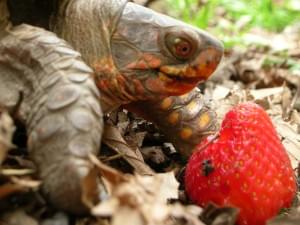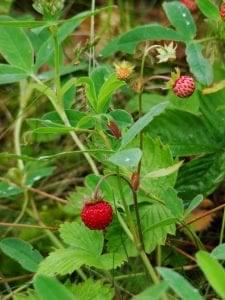
Nothing says summer like a ripening field of strawberries. The tingly scent of the freshly picked fruit can bring a smile to almost any child’s face. It makes the herbalist smile, too, as this delicate woodland plant offers a wealth of healing in one sweet, tasty package.
Medicinal Properties of Strawberry
Wild strawberry leaves are a storehouses of tannins – both condensed tannins and ellagitannins. These tannins have powerful astringent actions. They unclog pores and allow swollen tissue to breath. They also attack plaque on the tooth enamel with astonishing vigor. The condensed tannins are the compounds that collect catechins, which are heralded of late as antioxidants.
Just a taste of the strawberry’s fresh red fruit reveals its cooling and drying properties. A parched, swollen mouth feels instant refreshment after sampling a juicy strawberry. Wild strawberries are more condensed medicinally than the cultivated variety but both get the job done.
Strawberry’s antimicrobial properties are fairly mild. It’s just the right balance for daily use in dental care. The microbial balance maintains a healthy level even with intensive care. The vast amounts of vitamin C in strawberry fruit are a good guard against gum infections and the astringency in both the fruit and the leaf make a natural tooth and gum cleanser.
The nutritional value of strawberry is fairly well known. Vitamins C and A exist in this herb in abundance. Iron is also an important mineral in both the fruit and the leaf.
Conditions Best Helped by Strawberry
Strawberry, like other astringents, are good for treating diarrhea. The antimicrobial properties of strawberry leaf are strong enough to take care of plaque buildup on the teeth but not strong enough to trigger yeast infections like commercial antibiotics. Red, inflamed gums, loose teeth and stained teeth all respond to strawberry’s humble ministrations.
A cup of wild strawberry tea has enough tannins to successfully treat diarrhea. Its mild taste makes it easy to give to even small children without rejection. A little sweetener may be needed for fussier patients.
Fix a strong cup of wild strawberry tea and then let it cool down to treat sunburn. Dip a soft rag or cotton swab in the cooled tea to soothe sunburned skin. Combine this herb with calendula flower to increase its healing power.
If you have surface stains on the teeth from tea, tobacco, coffee or food dye, just take a bite of strawberry fruit. Enjoy the invigorating taste and then run the remains of the fruit near the stem on the surface of the teeth. It will scrub away discoloring quickly. Frequent use can have an effect on deeper stains within the tooth enamel.
For more information on the conditions best helped by Strawberry, see the topics in Conditions, including:
- oily skin
- loose teeth
- swollen gums
- diarrhea
- sunburn
List of Strawberry’s Medicinal Actions
Astringent, anti-diarrhea, antimicrobial, anti-inflammatory, antioxidant, and diuretic.
Medicinal Processing
Strawberry leaf is usually dried to make tea or tooth powders. It only takes a few hours in a food dryer or overnight on a flat air-drying surface like a screen or newspaper to turn fresh leaf into teapot ready product. Powdering the leaf is simple with the use of a blender or food processor. Do not overly dry this herb or it will loose its chlorophyll and flavor.
Although it’s uncommon, wild strawberry can be made into tincture as well. This could be used to strengthen mouth rinses. The leaf may be processed with a 1:1 plant weight to solvent weight ratio. It is processed with about 50 percent water to 50 percent pure alcohol. The range is flexible with this plant so feel free to play around with what suits your needs best. Whiskey is a perfect alcohol with which to to process wild strawberry leaf since it’s generally around 100 proof so it needs no watering down.
For more information on basic herbal preparations, see the topics in Herbal How-to.
Gardening and Gathering
Strawberry plants are amazingly easy to grow given the right amount of sun. Wild strawberries are even easier to grow than cultivated strawberries. They grow naturally in shady woodlands, scorched sand dunes or in the cracks of the driveway. These are North American natives that, although they do not have more than 10 years to live, pack a lot of action into their tiny lives.
Strawberries reproduce by runners that loop over the ground like loose stitches on a quilt hem. I brought four wild strawberry plants under the shade of my sycamore trees five years ago when I tore out my front lawn and now their cheerful little faces are stopped only by the sidewalk.
Strawberry’s shallow root system allows it a vast array of garden possibilities. Wild strawberry grows just as happily in the sandy soil at the coast as it does in the shaded, loamy dirt of the forest. Cultivated strawberry does best in well-drained soil that is heavily mulched. It can avoid its many predators by growing in raised beds where the fruit can overhang a ledge or flowerpot. Cultivated varieties can be relied upon to produce fruit for only three years before they need to be replaced but attention to providing organic compost every fall can stretch their lifespans considerably.
Who doesn’t know the familiar face of strawberry? It has a basal rosette of finely toothed, three part palmately compound leaves with smooth texture. The stems are thin and the flowers are yellow to white depending on the variety. The berries are red when ripe with tiny seed embedded on the outer flesh of the fruit. The roots are shallow and multiply by above-ground runners.
Wild strawberry is very easy to wild craft since it is unique in plant shape and flavor. There isn’t anything in the area that is toxic that looks like Strawberry. It is safe for children to gather and sample once they learn to recognize strawberry’s distinctive leaf and berry. This plant rewards good with a delicate taste that brings children back for another mouthful.
Quick ID tips
Appearance: Basal rosette of finely toothed, three part palmately compound leaves with smooth texture. The stems are thin and the flowers are yellow to white depending on the variety. The berries are red with tiny seed embedded on the outer flesh of the fruit. The roots are shallow and multiply by above-ground runners.
Taste: Fruit is sweet with tangy, distinctive strawberry taste. Leaves are bland with an astringent flavor.
Odor: Tangy, fruity scent – distinctive strawberry scent.
Using Strawberry to Care for Animals
Wild strawberry is excellent food for animals both wild and domestic. We used the leftover fruits from batches of wild strawberry jam to feed my daughter’s bearded dragon much to his delight. We let the chickens pick through the ground cover to eat the fruit the sparrows left behind. In the spring, these early bloomers also provide pollen for our native bees.
Both wild and cultivated strawberries provide essential supplies of vitamin C during the winter months for birds and reptiles. These fruits can easily be dried or frozen for later use. Some animals are picky about their food temperature or food size. Chickens often need their dried fruit to be crushed into bite sized pieces for easier consumption. Bearded dragons, for instance, will eat frozen food but only after it’s been defrosted.
Strawberry leaves are good to add to the bath water for treating a dog with oily skin. Dogs don’t find the smell overpowering and strawberry leaf is an excellent astringent that doesn’t stain a bathtub. Strong strawberry leaf tea makes an excellent compress for animals with oozing hot spots or swollen paw pads.
Try adding cooled tea in a bowl next to an animal’s drinking water to help relieve his or her swollen gums and reduce the inflammation. If the animal doesn’t like the flavor of the tea, try diluting it more. Do not replace an animal’s drinking water with a liquid he or she might not like. The animal may simply chose not to drink at all. Dehydration is extremely dangerous, particularly for an animal who is already sick.
Household Formulas and Non-medicinal Uses
Wild Strawberry leaf tea makes a wonderful substitution for fans of green tea when caffeine is a problem. The mild flavor is delightfully refreshing and can fool all but the fussiest green tea connoisseur.
Strawberry is a perfect base for jams, jellies and chutneys. There aren’t many canning cookbooks that don’t have a few recipes for using strawberries. Wild strawberries are smaller and seedier than cultivated strawberries so some straining or extra cooking time to thin the seed content and sweeten the dish may be needed.
Frozen strawberries are excellent in smoothies and milkshakes. To freeze strawberries, rinse the fruit and then place a thin layer of berries on a waxed paper coated cookie sheet. This prevents the berries from forming a solid mass of berries when they come out of the freezer. Place the frozen strawberries in labeled and dated freezer bags or containers up to 1 year. Berries are prone to freezer burn so watch the dates throughout the winter before using them.
Dried strawberries can be used to sweeten teas or hot cereals. Throw dried berries into trail mix or granola or a extra kick of vitamin C. Try powdering dried strawberries to sprinkle on cakes or cookies for naturally sweet food coloring.
For more recipes and ideas for using Strawberry, see the topics in Recipes.
Cautions for Strawberry
An allergic reaction in the form of a rash to strawberry leaf contact is extremely rare but not unheard of. Strawberry fruit is an uncommon (less than 1% of the population) but serious allergen. Avoid eating the fruit if there is a known or suspected allergy to strawberries. People who are allergic to the leaves do not often report an allergy to the fruit and visa versa.
For more information see our History, Folklore, Myth and Magic page on Strawberry.
For further information on Strawberry including updated text; Advanced Medicinal Processing; Recipes; History, Folklore, Myth, and Magic; a Printable Quick Facts Page; and References, buy Strawberry: A Wealth of Healing in One Sweet Tasty Package on Amazon, volume 1 of our The Practical Herbalist’s Herbal Folio series.







